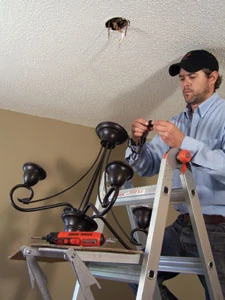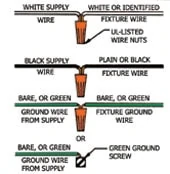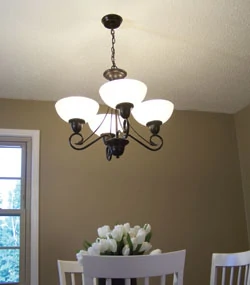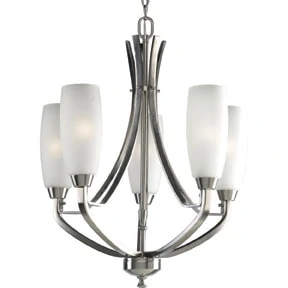Light up your life—from above.
By Matt Weber
Replacing an out-of-style ceiling fixture not only updates the look of a room because of the new fixture’s appearance, but the manner in which it casts light can also dramatically impact the ambience of the living space. From single-light fluorescents to elaborate dining room pendants, ceiling-mounted light fixtures are prominent features of the interior décor.
Ceiling fixtures range in style from elegant chain-mounted chandeliers with sparkling crystals and candle-style lighting to more modern track-style fixtures that feature multiple, adjustable lamps that operate from a single electrical box.
Regardless of style, the major concern when selecting a replacement feature is to ensure that the box, ceiling and wiring will support the weight of the fixture. For a new fixture that weighs approximately the same as the old one, the existing electrical box will probably suffice. However, if the replacement is heavier, the ceiling box may need to be replaced to support the extra weight.

Out with the Old
Replacing a light fixture doesn’t require an electrician. Following a few simple safety guidelines, a DIY homeowner can easily replace a fixture successfully, although the work should be inspected by a professional. Also, check with local authorities to see if a permit is required.
Before making your first move, turn off the power at the breaker box. Do this by flipping a circuit breaker or unscrewing a fuse. Use a voltage tester to make sure the power is off.
When removing the old fixture, use a work platform fastened to a ladder to support the weight of the fixture while you remove the mounting screws from the electrical box. With the screws out, pull off the box cover and disconnect the wiring. The wires should be twisted together and capped with a wire nut. To disconnect, just unscrew the wire nut and untwist the wire pairs.

Assemble the Fixture
Organize the fixture’s components, including the canopy, the hanging hardware, etc. Because ceiling fixtures vary greatly in style and construction, so do the associated components and the assembly process. However, any quality lighting manufacturer will include assembly instructions specific to the fixture model, and usually the job requires nothing more than a screwdriver. The cord of the light fixture follows the chain, looping through it periodically to keep the cord and chain bundled. Remember to thread the box cover, the new mounting strap (which screws into the junction box) and any other necessary parts over the wire and chain before installing.
Next, use your ladder/work platform combo to support the weight of the fixture. Ultimately, the height of your hanging fixture is up to you. However, hanging fixtures are often positioned above focal points, such as a dining room table. In that situation, a good rule of thumb is to install the fixture about 30 inches above the table. To do so, it helps to have an assistant hold the fixture in place on the ceiling while you measure the distance and adjust the chain accordingly. To shorten a chain, just cut it to length with metal snips, and then cut the wiring 6 inches longer than the chain.

Wiring Basics
In modern wiring, individual wires are bundled together in a sheathed cable. “Two-wire with ground” cables have a black wire, a white wire and an uninsulated ground wire. “Three-wire with ground” cables (used with three-way and four-way switches) have a black wire, a white wire, a red wire and an uninsulated ground.

Older homes have “knob and tube” wiring. Instead of cables, “knob and tube” wiring is a two-wire system in which individual wires are insulated with white or black treated fabric.
Regardless of your wiring system, the white wire is usually the neutral wire, and the black is the live or “hot” wire. Any red wires are hot, too. The unsheathed, exposed copper wires are ground wires. (Note: In some cases a wiring installation may require a white wire to be hot, in which case it should be marked with black tape. However, just because it should have been marked doesn’t mean that it was marked.)

If only a single cable, or one set of black and white wires, enters the box, then the fixture is at the end of the circuit. This is common—but not guaranteed—with ceiling fixtures and allows for the simplest method if installation. If two cables (or two sets of black and white wires) enter the box, the fixture is in the middle of a circuit. The placement of the fixture within the circuit affects how it is wired. If a light is in the middle of a circuit, you will have to twist multiple wires together.

Those general wiring guidelines should give an idea of how to identify the hot and neutral wires of the supply cable. However, many light fixtures do not actually have black and white cables, but it’s still important to connect the neutral wire of the circuit to the neutral wire of the light. To identify the neutral wire, examine the lamp cord closely; the neutral wire usually has a white rib on the sheathing as its indicator.

Get Connected
All that’s required for installation is a screwdriver, a ladder and some wire strippers. It may help to screw the mounting strap to the junction box to keep the wires close together while you work. Using a combination stripper, pinch the wire in the appropriately sized hole, squeeze to cut the sheathing, and twist and pull to remove about 3/4-inch of insulation from each wire. Match the fixture wires to the supply wires according to sheathing color (hot to hot, neutral to neutral), twist the exposed wires together clockwise, and secure them with a UL-listed wire nut. Install a light bulb and test the connection before installing the fixture. If there’s no illumination, you probably have a loose connection, so try again. Once the light functions, add some extra connection protection by wrapping electrician’s tape around the wire nuts.

If you haven’t yet installed the mounting strap, then screw it to the junction box. Then screw the threaded mounting stem on the chain solidly into the mounting strap. Finally, cover the junction box with the cover or “canopy” and secure it in place with the locknut included with your light fixture.
That’s all it takes for a contemporary lighting update to your interior décor.
Editor’s Note: Special thanks to Progress Lighting for supporting this project. Visit www.progresslighting.com.



